When Did Animal Testing Start For Cosmetics
Please note that as an Amazon Associate and a member of other affiliate programs, I may earn a pocket-size committee at no boosted cost to you when you purchase from the links in this article.
Each year more than 500 000 animals are harmed, tortured and slaughtered for the purposes of animal testing for cosmetics. And that'due south just i role of the trouble.
More than 100 meg animals, in the U.s.a. solitary, are used for testing in other industries and for other purposes every bit well. These include the drugs and food industry, the cosmetics industry, medical and biological science trainings, scientific enquiry and experimentation, and so on.
All these animals are crammed in crowded cages and live miserable lives. They don't get any protection from corruption. They're tortured beyond whatsoever upstanding limit. They are only bred and kept alive as long as they can be of apply for animal testing in the cosmetics industry. After that, these companies that perform the tests just get rid of them in the most cruel ways you can imagine.
Most people are unaware of the correlation between the cosmetics industry and the horrific treatment of animals.
Then, have you ever idea almost the fact that maybe your skincare, haircare and makeup routine may be causing harm to animals?
Animate being testing for cosmetics 101
A lot of people are confused as to what animal testing actually is, why information technology is cruel and how nosotros can stop information technology. In this article, nosotros aim to reply the post-obit questions:
- When and why did nosotros starting time testing on animals in the first place?
- What kinds of tests are performed on animals and what'southward so cruel about them?
- Are the tests the merely ethical problem?
- Are ethics the just problem with animal testing?
- What alternatives to animate being testing are there?
- Where is testing on animals banned? And what'due south the deal with China?
- How tin can I help? How do we get companies to stop testing on animals?
- What does cruelty complimentary mean?
- How exercise I tell if a product or make is cruelty free?
- What is the official cruelty costless logo and certifications?
- Will my cosmetics choices make whatsoever difference?
The goal of this article is to provide some more than insight and information to assistance educate everyone and raise awareness regarding this horrific practice.
We hope this is going to exist a valuable resource for people who are unaware of this practice, every bit well equally for anybody who just wants to learn more than about the background of the animal welfare move.
Instruction on topics such as this ane is very important to help us make better choices equally consumers when purchasing corrective products if we don't want to support animate being cruelty and brand a deviation in the lives of our swain earthlings.
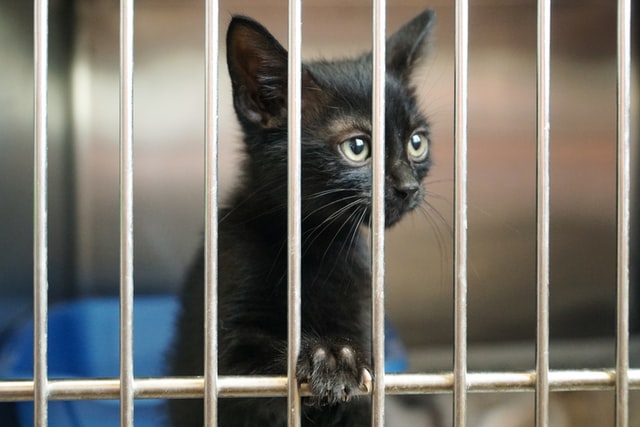
A brief history of animal testing for cosmetics
In the commencement of the 20th century, in that location was virtually no regulatory command in the United States regarding the safety of drugs and cosmetics.
In 1937, a pharmaceutical company based in Bristol, Tennessee, named "S. E. Massengill Company" was responsible for a mass poisoning as a result of their medicine Elixir sulfanilamide. A component within this medicine turned out to be extremely toxic. More than 100 people throughout the United States died as a result of this poisoning outbreak.
Moreover, this scandal inverse millions of animal lives forever. As a response to this incident, in 1938, The U.s.a. Food, Drug & Cosmetic Act was passed. This is what pressured companies to enforce animal testing for cosmetics and similar products for the first fourth dimension, in club to ensure prophylactic for humans.
Ever since this law was passed, animals throughout the world accept been subjected to all kinds of testing methods. For the purposes of the cosmetic industry, private ingredients too as finished corrective products are tested on animals. But one new ingredient tin lead to more than than 1400 lost animal lives.
The most commonly used animals for these types of tests are rabbits, just mice, rats, and even primates and kittens are too frequently used.
What types of tests are performed on animals? Why is fauna testing roughshod?

All types of fauna testing include animal exposure to dangerous chemicals in abnormal (usually lethal) doses. They unremarkably inject the animals with these substances, or forcefulness them to inhale or ingest the chemicals, etc.
Here are some examples:
Draize middle test
A substance is placed in the rabbit's optics, with the intent to evaluate whether the chemical is an irritant. The rabbits are restrained for weeks so as to find the furnishings of the substance for longer periods of fourth dimension.
These tests upshot in several chemical and mechanical injuries including bleeding and ulcers, and most times even incomprehension.
Acute toxicity
These types of tests include rats and mice, and are based on exposure to dangerous chemicals by mouth, inhalation or skin. In the by, the Lethal Dose 50 tests were washed, which are conducted until at least one half of the test animals die.
The surviving animals are killed afterward the experiment so that an dissection can exist performed.
Unfortunately, that's just the beginning. Animals are also burned, starved, drowned, brain-damaged… They're as well infected with all kinds of diseases. Bunnies and kittens are blinded, rats and mice grow tumors as large as their ain bodies, they suffer seizures and brain damage.
Cheque out The American Anti-Vivisection Order for more details.
The test itself is only part of the issue – at that place are other reasons why animal testing is fell
In addition to the gruesome tests, the animals used in these experiments live in the most miserable conditions.
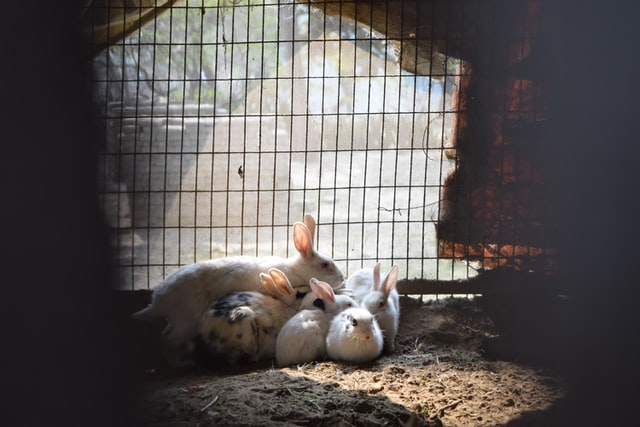
They're dumped in crowded cages and are not given any painkillers or medication subsequently the painful procedures they've been put through. All animals in these labs alive in fear, starved and mistreated. They are terrified whenever someone walks by.
They never know when they'll exist taken out of their cages for another horrible process, or possibly killed just similar the rest of the animals they come across getting killed right in forepart of their eyes every day.
Animal testing is unreliable and inaccurate
At least all this pain and suffering provides assurances that the products are prophylactic for human usage, correct? No.
Animal testing is not just cruel, but also the least reliable and nearly expensive of all the testing methods we have available today.
In the mod world, it is completely redundant and obsolete. The truth of the matter is that tests performed on animals aren't even accurate as there can be many differences between the effects of these ingredients in humans and animals.
Let'due south have the Draize eye examination as an example. There are several pregnant differences between the structure of the optics and the volume of tears in humans and in rabbits. Different species of animals (including humans) take wide variations in responses to chemicals, regardless of the way they're administered.
Similar issues exist with other types of animate being tests for cosmetics as well. This makes all of these tests unreliable, and therefore obsolete.
Animate being testing alternatives are ethical, cheaper and more than accurate
At that place take been significant advancements in the development of new alternatives to animal testing (known as in vivo tests). Some of these alternatives include in vitro testing, computer (in silico) modeling and research with man volunteers.
I have an entire post well-nigh how cruelty gratuitous products are tested, so cheque it out if you want to acquire more.
Harvard'south Wyss Found has created "organs-on-chips" which are based on man cells that are grown to mimic human organs, both structurally and functionally. These microchip organs tin can exist used to written report the effects of unlike substances by modeling human organs.
On the other hand, some tests are based on computer models. Researchers have developed algorithms that tin can employ big databases of chemicals to predict whether a substance is toxic or not.
Biologists take been experimenting with computer models of human organs for a while now. With the evolution of this technology and with ameliorate statistical and experimental information availability, these models are more than accurate than ever.
Testing of new ingredients and substances is at present possible through computer-based simulations, which can be used for drug trials. 1 of the most sophisticated models is that of the human heart, but there are models for several other organs relevant to testing besides.
Of course, these are just examples. There are other alternatives to brute testing as well, and new ones are existence adult each twenty-four hours.
Generally, in vitro, in silico and similar tests take less time than tests on animals take to clarify, are cheaper, and give equally or more accurate results.
Some countries ban animal testing for cosmetics and for others, it's nevertheless mandatory
European union
There are three important animal testing bans in all 27 fellow member states of the European union every bit of 2020: the two testing bans and the marketing ban.
Testing bans:
There were several attempts to ban fauna testing for cosmetics within the European union earlier 2004, however, the lack of alternative methods postponed these efforts.
In 2004, the European Spousal relationship banned creature testing of finished cosmetic products within the EU.
In 2009, the Eu banned testing ingredients on animals within the European union.
Marketing ban:
In 2013, some other animal testing ban was introduced in the European union, which refers to a prohibition of auction of cosmetics and ingredients in the EU that have been tested on animals.
These prohibitions were introduced regardless of whether alternative tests be.
United States
In the United States, the situation was at a standstill until the starting time of 2020, when three states – California, Illinois and Nevada made the first motion and banned the auction of cosmetics tested on animals.
However, we're still waiting for a nationwide ban.
Other countries
Other countries that have banned/restricted brute testing for cosmetics are Norway (2013), Israel (2013), India (2014), New Zealand (2015), South korea (2015), Turkey (2016), Guatemala (2017) and Taiwan (2019).
However, these bans do non utilise in certain cases. Animal testing for cosmetics is still performed.
Although it depends on the country in question because unlike laws and regulations utilize everywhere, these bans usually contain several loopholes:
- They usually don't apply when companies innovate new ingredients that haven't previously been tested on animals. In such cases, tests are usually withal required.
- Another case when these bans usually don't apply is when the products are exported in, or imported from other countries.
- Sometimes, they only apply when non-creature culling tests exist for that detail test that needs to be performed.
- There are as well several exceptions in cases of environmental and health concerns.
- Most times, there are other specific requirements for raw ingredients and materials used in cosmetics such as sterilizers, preservatives, etc.
These loopholes are unremarkably provided nether other regulations/laws. In the EU, one instance is the REACH regulation.
REACH
REACH (Registration, Evaluation, Authorisation and Restriction of Chemicals) is an EU regulation, which was introduced in 2006.
According to this regulation, companies must provide information regarding health and environmental condom of each chemical they utilise.
For a lot of these chemicals, brute experiments have already been performed in the by, pregnant that such information already exists. All the same, for each new chemical introduced, in order to provide the information required by the REACH regulation, some companies within the EU still examination on animals.
And what nigh animal testing in China?
China is one of the most controversial countries regarding this question.
Until recently, pre-market and post-market place creature testing was required by law for all cosmetics physically sold in mainland Communist china.
In 2014, the Chinese government stopped requiring cosmetics produced in China to be tested on animals. However, such testing remained required by law for all imported cosmetics.
In 2019, China stopped requiring routine post-marketplace testing of cosmetics. As ever, there are other loopholes as well, such as animate being testing for cosmetics that accept been subject to customer complaints, wellness concerns, etc.
The requirement to perform pre-market fauna tests of imported products yet stands.
Also, proceed in heed that all of these law relaxations refer to having mandatory animate being testing for cosmetics. Unethical treatment of animals for testing in the cosmetics industry is still not banned in China, significant that companies that sell in that location tin notwithstanding perform tests on animals.
Boycotting brands that test on animals is the most effective solution to stop creature testing for cosmetics
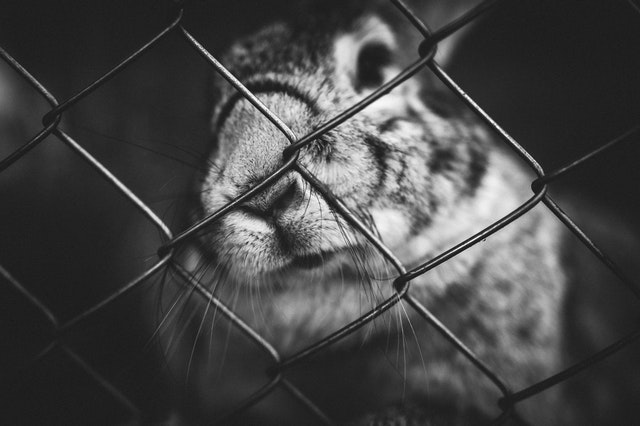
Animal rights activists and proponents of the animal welfare movement have been trying to get the public attention for years.
Many petitions have been signed, protests against animate being testing accept been attended by thousands of people, but these efforts still haven't stopped these companies from testing cosmetics on animals.
Companies, withal, usually adhere to the cliché and are motivated by profit. So, the nigh powerful manner to show them that unethical treatment of animals is not acceptable, is to stop supporting them and stop buying their products.
If the demand for cosmetics that are non tested on animals keeps increasing, and fewer people are buying from brands that still examination their products on animals, these companies are going to realize that they're losing money.
Boycotting brands that examination on animals aims to force them to follow their ethical competitors' case. By boycotting brands that test on animals, we're going to help them see that nosotros're against animate being testing and that fauna welfare is of import to us equally their customers.
Buying cruelty costless products also helps support the brands which have decided to put an end to beast cruelty. If nosotros continue to support them, they'll proceed producing more cosmetics that are not tested on animals.
This consumer beliefs sends a clear message to companies that they need to change their creature testing policies in lodge to be successful on the beauty market.
What is the definition of "cruelty complimentary"? What does information technology actually mean?
"Cruelty costless" means that no animals have been harmed and no brute cruelty was involved during the product of that detail product.
The definition according to Wikipedia:
Cruelty-gratis is a label for products or activities that do not harm or impale animals anywhere in the globe.
"Cruelty free" lacks a formal, legal definition though, which by itself is a source of some problems. This term is not regulated past any authorities, which is a picayune disruptive because some brands call themselves "cruelty gratuitous" and this might mislead the customers in some cases.
Equally we saw in the previous sections, one of the nearly common ways animals are harmed during the product of cosmetics is animal testing.
Then, the widely accepted significant of "cruelty gratis" is "non tested on animals".
"Vegan" and "Cruelty Free" are dissimilar things
There are several debates regarding this question – some people consider "cruelty free" to be a subset of "vegan", because products that use animal-based ingredients within them usually learn them in means which are cruel to animals.
However, it is by and large accepted that:
- "vegan" means that no animate being by-products and animal-based ingredients are used inside the product; and
- "cruelty costless" ways that the manufacturing of the product doesn't cause cruelty to animals, and by and large refers to the fact that the product hasn't been tested on animals.
A product tin can be both "cruelty costless" and "vegan". Information technology can besides exist "cruelty free" simply not "vegan", and vice versa.
What does it accept for a product or make to be considered cruelty complimentary?
A production is cruelty free if the finished product and all of its ingredients haven't been tested on animals by anyone, anywhere in the world.
Some brands will claim they're cruelty free considering they don't exam the finished product on animals, disregarding the fact that the ingredients have been subject area to animal testing.
Other brands only claim that they don't test on animals, non taking into account:
- that their suppliers test the ingredients before they're used in their products
- that 3rd parties exam the ingredients or finished products
A production tin can't be cruelty free in ane country and tested on animals in some other land. It tin't be "partially cruelty gratuitous, except this one ingredient". Information technology's either tested, or not tested on animals. At that place's no in between.
A cruelty costless brand is a brand that only produces and sells products that haven't been tested on animals. Neither of their finished cosmetic products are tested on animals, and neither of them contain ingredients which have undergone such testing.
Again, a make either is, or isn't cruelty gratis. At that place's no in between. You can't say "this make doesn't test on animals, except for this one product".
The general idea is that when buying from cruelty gratuitous brands, y'all tin can be certain that your coin would non go to the aforementioned set of people who blind rabbits, burn mice or hurt kittens.
Parent companies that test on animals
Ane thing to note here is that some people don't consider companies every bit cruelty free if they are owned past companies who perform these tests, fifty-fifty if they themselves don't test on animals.
The generally accepted stance is that equally long equally the company doesn't inherit its parent company's animal testing policy, it tin be considered cruelty free.
Withal, if you're non comfortable using brands with parent companies that test on animals, that's understandable. Always do more thorough research in order to conclude whether a visitor is cruelty gratuitous co-ordinate to your ethical standards.
Certifications, labels, logos…
As nosotros previously saw, the term "cruelty gratis" doesn't really have a articulate legal definition. This means that companies tin put such labels on whatever products they like.
Meet my postal service on cruelty free certifications to learn more near the problems with cruelty complimentary labels and certifications.
So, there isn't really an official cruelty free logo either.
Some companies claim they're confronting animal testing and their products are cruelty complimentary, but they're sold in China where they might be tested on animals. Others claim their cosmetic products are not tested on animals, only their ingredients are produced by suppliers which test said ingredients on animals.
Withal, there are three certification programs for companies that don't perform animal testing for their cosmetics products. These three programs are regulated past three dissimilar organizations.
Each of them has its own specific requirements and standards, so a brand certified as cruelty free by one of the programs, might not be considered as such by some other.
Beauty Without Bunnies
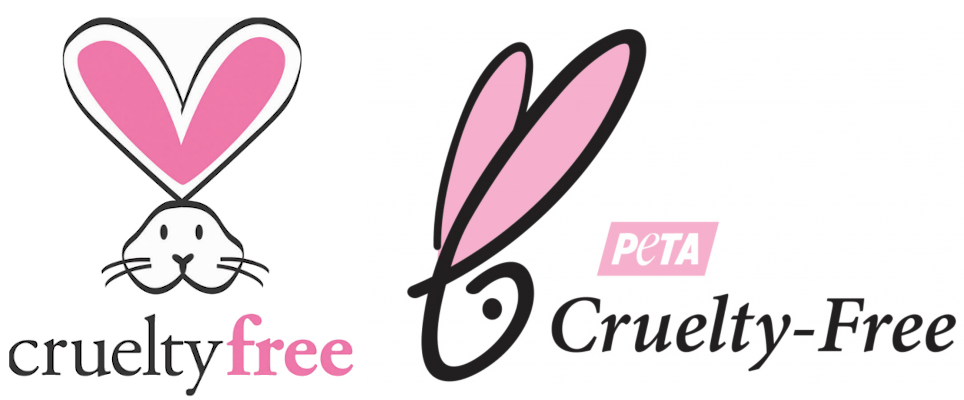
PETA's Beauty Without Bunnies program is the most popular cruelty free program out there.
More than than iv,500 companies are canonical by Beauty Without Bunnies.
To be added to PETA's upstanding brands list, each company must make full out a questionnaire and sign a "statement of assurance", stating that neither the finished product, nor the ingredients take been tested on animals.
Yet, there are a couple of things that you demand to know:
- PETA approves fifty-fifty brands that say that they don't test on animals except when required past constabulary (those selling in China).
- They don't actually verify if the brand doesn't perform fauna testing, but the cruelty free status only depends on the answers in the questionnaire. We need to rely on the honesty of these companies. We promise that they're answering the questions truthfully, only we can't be sure considering no proof is required for these statements.
- Beauty Without Bunnies doesn't perform reassessments periodically.
Therefore, not all brands on PETA'south list can be trusted. E'er check other resources before deciding to buy a product by a brand on the Beauty Without Bunnies listing.
Leaping Bunny
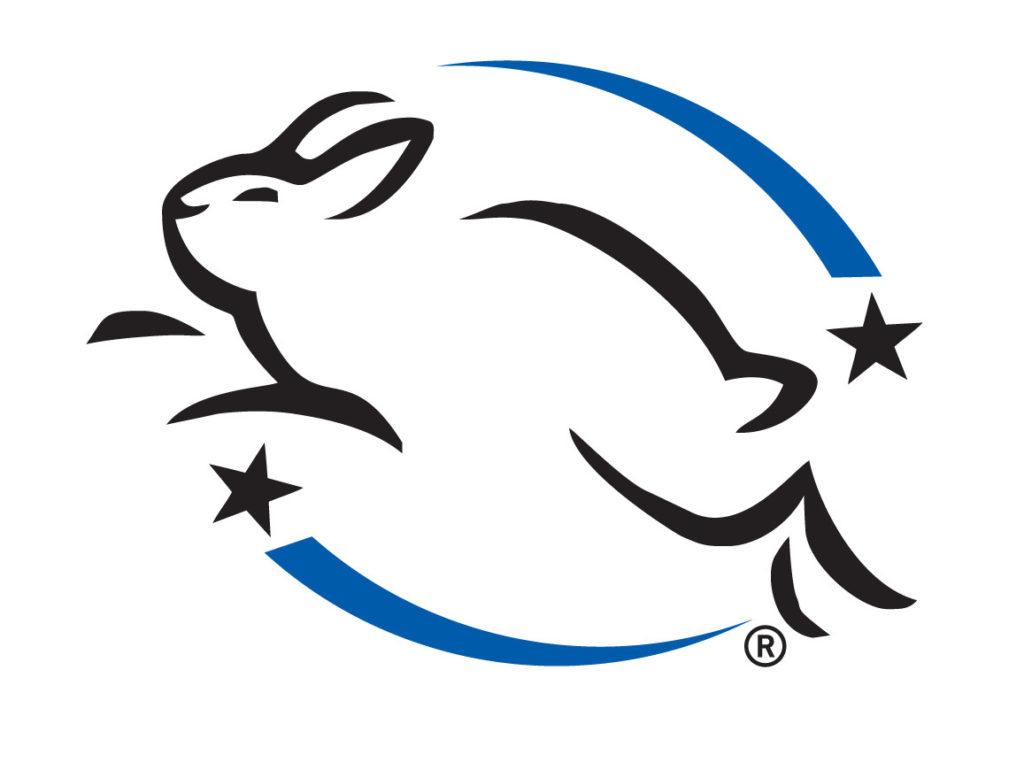
Leaping Bunny is the most reputable plan for ethical cosmetics and is known as the international "gold-standard" of cruelty gratis products. It was established by the Cruelty Free International and the Coalition for Consumer Data on Cosmetics (CCIC).
More than i,800 brands are Leaping Bunny approved.
They have very strict criteria for the companies seeking to get approved, too equally for their suppliers. The Leaping Bunny certification likewise requires evidence to be provided by the companies for all claims.
The list of requirements includes, but is not limited to the post-obit criteria:
- the company must non bear, committee or be a political party to beast testing of finished products and ingredients
- the visitor must non buy ingredients from manufacturers who exam on animals
- it must ensure that their suppliers practise not test on animals past implementing a "supplier monitoring system"
- the company must not allow their products to be sold in countries where there are regulatory requirements for animal testing
- they must concur to recommit annually
- they must agree to an independent inspect
One thing to note here is that Leaping Bunny also approves some of the brands with not-cruelty complimentary parent companies. However, they must promise to accept their own supply chains independent of their parent companies and work as standalone subsidiaries.
You can see the Leaping Bunny FAQ for more information.
Choose Cruelty Gratuitous
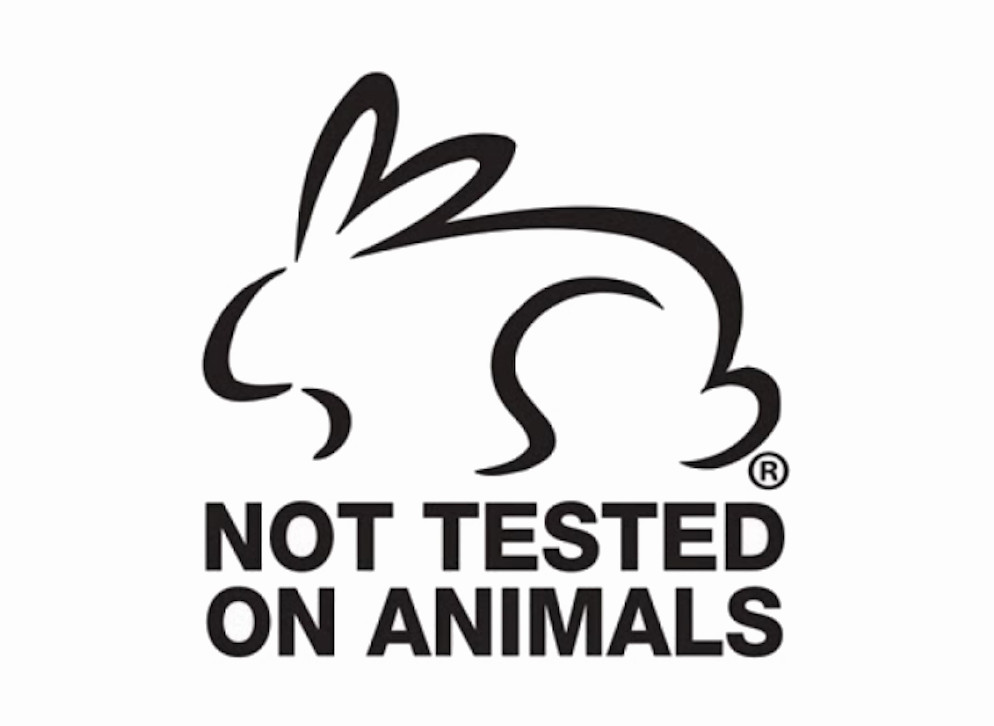
Choose Cruelty Free (CCF) is an independent, not-profit system based in Australia.
Although mostly targeted at Australian brands and consumers, they've recently also become relevant internationally.
CCF is a peachy resource as they likewise take lists of brands which are not only cruelty free, just besides vegan, vegetarian and palm oil free.
They have very strict accreditation criteria, which include checking whether animal testing is performed through the entire supply chain.
Apart from testing on animals, they're very cautious of ingredients too – they have a listing of ingredients which are acceptable, and a list of other ingredients which are almost always acquired from animals in cruel ways.
Some other of import difference between this other certification programs is that they don't approve brands endemic past parent companies that examination on animals.
This is a quote from their website:
We certify based on the 5 year (or +) rolling rule whereby all products and ingredients must be free of animal testing past the applying brand, owning visitor, contract manufactures, ingredient suppliers and anyone interim on their behalf for a flow of five years immediately preceding the date of application for accreditation.
In improver, CCF will not certify brands who sell in retail markets that require creature testing i.e. China.
Conclusion near cruelty free certifications
Don't trust labels and logos implicitly. Cruelty free certification, as discussed to a higher place, oftentimes comes with caveats attached. Some certification programs have more strict criteria than others. Sometimes yous'll find a brand listed in i list, but information technology'll be missing in other lists.
Always do your ain research and check whether the brand actually doesn't exam on animals before buying a product. Yous tin observe enough of information online.
There are several blogs such as this 1 that don't just reply with "yes" or "no", only also try to explicate more thorough information nigh each brand, so you lot can see whether it fits within your criteria of cruelty free.
Going cruelty free actually does assist stop animal testing for cosmetics
By buying products from brands that employ animal-based ingredients and exam on animals, you're directly supporting animate being abuse.
Let's put an end to creature cruelty! The least we can practise is show the world that harming animals is no longer normal and acceptable.
Some cosmetics companies have gone cruelty gratuitous as a result of the pressure level to stop fauna testing
The most famous example is CoverGirl. When they got acquired by Coty, they made the determination to stop selling their products in Cathay and got Leaping Bunny certified.
When large companies stop testing on animals, they use the media coverage to their advantage to promote themselves. However, this is a adept thing, because it too helps spread the message and gets other brands to follow the example.
Reach out to your favorite brands
If some of your favorite brands still examination cosmetics on animals, let them know that this is no longer adequate to you.
Ship them an e-mail explaining that although their products are great, treating animals respectfully is of import to you. Kindly inform them that they've lost you every bit a client as a result of their animal testing practices. Tell them that you'd love to see them change their testing policy and go cruelty free.
Spread the message
At that place's no reason to be pushy and blame other people who accept made choices different than ours. That'due south just going to be counterproductive. Some of them haven't even considered making this choice still.
If you're in this category, we hope that this gives you a lot of reasons to consider going cruelty free. Join us in our efforts to end animal testing for cosmetics throughout the globe!
However, educating others tin can be really helpful. Most people are not aware of the effects that the cosmetics industry has on animals. Who would take guessed that animals dice just so nosotros can have longer lashes?
Brainwash people who are unacquainted to the pain and suffering of animals every bit a result of animal testing. We're sure that a lot of them would love to help.
Spread the bulletin to your friends and family unit. We can make a huge change by making at to the lowest degree some of our consumer choices more informed.
Commencement making better consumer choices
Next time yous're shopping for makeup or cosmetics mostly, only think about the horrible animal testing practices. When deciding which make to pick, check whether it's been tested on animals.
Even if you don't go 100% cruelty costless, the alter y'all're making is noticeable in the large scheme of things.
Is choosing another brand of mascara to save one animal life worth it?
And now, we'd like to hear from you! Have y'all tried to switch to cruelty free products? If and so, did you find it hard? Practise you trust the certifications?
Tell u.s. in the comments!
Source: https://crueltyfreeonly.com/animal-testing-for-cosmetics/
Posted by: loafters.blogspot.com

0 Response to "When Did Animal Testing Start For Cosmetics"
Post a Comment